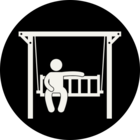I have trail data from two different sources and am trying to figure out where they overlap, and where they don't. There is any combination of A, B or A+B. Where the trails do overlap they misalign ever so slightly. I have tried two different methods but have not yet got satisfactory results out of any of them.
Most promising so far seems to be Buffer plus the LineOnAreaOverlayer. My gripe here is that it creates small gaps, see arrows, where a small piece of a segment that does not actually overlap gets registered as an offender. The red is the outline of my buffer, the greens are coupled lines and the blues are singles.

How can I keep the blue segments intact? All incoming segments have ID's, so maybe there is a way to rebuild them from that? It does feel like a slightly cluttered method that would also problems elsewhere. Some places the trail goes from A to B to A+B and back to B - and so on.
Any ideas on how I could get this to work?

Just as a side note: I began with a AnchoredSnapper in combination with the LineOnLineOverlayer. But is seems the many segments hinder it from getting the precision needed for the overlayer to do its thing.






